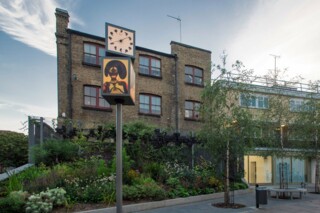At Peer
Lauren Kelly
The first thing you see outside the Peer gallery in Hoxton is Black Hands, an installation by Chris Ofili. It consists of two illuminated boxes at the top of a tall pole: the upper box has clocks on its four sides, with silhouettes of heads in place of numbers; the lower one, which rotates slowly, carries four large portrait heads. Around and below it are trees, paving, a raised flower bed, seating, bike parking, and a mural by Jacob V. Joyce and Rudy Loewe, commissioned by the gallery. Peer, a non-profit organisation, integrates art into the local environment. Cultural democracy is the idea, founded on the belief that art and social institutions should be associated, if not interdependent.
Such initiatives were commonplace in the 1970s and 1980s, as traced in Peer’s recent exhibition we are a group of people composed of who we are. Its starting point was 1971, the year Centerprise was established in Dalston. Archival clippings and video footage told the co-operative’s story: art, drama and chess clubs for the young, adult literacy classes, publishing assistance (mainly poetry and autobiography), film events and poetry readings, childcare, legal advice. With a bookshop at the front and a small coffee bar at the back, Centerprise was a hub for intellectual activity.
The community arts organisation Free Form was founded in 1973. Ron Orders’s documentary Somewhere in Hackney shows some of their murals, plays, festivals and urban planning projects. One of the artists explains Free Form’s purpose as being ‘to achieve a physical change, to create a physical image for the places they live in’. ‘Community arts gives people the confidence to do things they haven’t done before,’ someone else says. The Lenthall Road Workshop, a feminist printmaking workshop, was founded in Haggerston in 1975. There’s footage of pensioners having lunch and dancing at Hoxton Hall, a performance arts theatre and community centre near to where Peer now is.
we are a group presents culture as a way to effect change. In Somewhere in Hackney, a young Asian woman at Centerprise reads ‘Black Is Not a Skin Colour’,a poem she wrote in 1976. ‘There’s a lot of fatalism,’ she says. ‘A very common attitude. And writing poetry can be a way of disturbing that attitude, for yourself and others.’ Ingrid Pollard’s poster Black Lesbian (1984), made at Lenthall Road, is displayed alongside an Anti-Nazi League campaign poster by Neil Martinson and Dan Jones. Photographs by the Hackney Flashers from their exhibition Who’s Holding the Baby? (1978) show a mother wringing laundry while her children eat at the table; another unloads the shopping as she sees to her daughter.
In Somewhere in Hackey a woman recalls how, before Centerprise, she hadn’t heard of the radical feminist magazine Spare Rib, and would read children’s books instead. In a meeting at the Hackney Writers’ Workshop, a man shares a poem describing his experience of being held at a police station.
Still, failing to appeal to the ‘ordinary’ working classes was a common criticism. Centerprise responded in its annual report for 1978: ‘There is no such thing as the ordinary working class, only working-class people with a variety of interests, coming from a variety of geographical and religious backgrounds.’ Centerprise’s first publication was a book of poetry by Vivian Usherwood, a twelve-year-old in care in Hackney. He sold 18,000 copies and went on to read his work on the BBC.
After Thatcher’s government abolished the Greater London Council in 1986, materials and resources slipped away. Centerprise became a shadow of itself, and in 1993 its era of co-operative management ended. In 2012 the organisation was evicted by Hackney Council, after 42 years, following a massive rent hike.
Cultural institutions themselves, however, can push out communities. When a multi-use arts centre opens, house prices go up. The average in Hackney is now more than £700,000, almost three times the national figure, though that’s hardly Peer’s fault. If you look at the gallery’s façade, in a converted shopfront on the Arden Estate, the community focus is clear. The garden, planted and maintained by locals, has been named in memory of the artist Khadija Saye, one of the 71 people who died in the Grenfell Tower fire.
